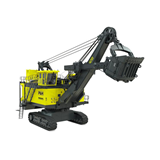By 2015, the Chinese economy will reach $15 trillion (currently it is at around $9 trillion). What this means for the Australian mining sector, is a continued surge in demand for this country's minerals, mainly copper, coal and aluminium.
According to The Treasury of the Australian Government, China's economy has leapfrogged from being just four per cent of the US economy in 1980 to nearly 90 percent the size of the American economy in 2015. Additionally, China now boasts the world's largest urban population, with 630 million urban citizens. The growth of its towns, cities, technology and commercial parks, shopping malls and recently built cultural centres is creating a huge demand for Australian minerals for construction-related work.
"Planning and construction happens at a very fast rate in China, as compared to the West," said Robert Caulfield, a leading Australian architect and commercial property spokesman who is helping to design a $3 billion technology park 200 kilometres west of Shanghai. "The proliferation and scale of expansion and construction-related work across China is staggering."
With greater urbanisation comes an increase in steel consumption. China is also the world's biggest market for aluminium, steel and copper; resources for which Australia leads the global export market.
Currently, China takes in a 34 percent share of the world's aluminium, compared to 20 percent by the US, and just 6 percent by Japan. China's consumption of finished steel is 35 percent, compared with less than 10 percent for the US. China also consumes about a third of the world’s copper, whilst the US just 12 percent. Australia's mining sector is also a major supplier of copper to China.
Additionally, the recent expansion of Chinese infrastructure by the national government has seen numerous airports, ports, roads, highways and other government buildings dominate the landscape. As a result, China's demand for Australian minerals has ballooned by no less than 400 percent in the past decade (2000-2009)! In that period, China's share of Australian exports increase from a mere 5 percent in 2000 to over 20 percent in 2009.
But the best is yet to come. Between 2009 and 2015, China's demand for Australian exports (mainly copper, aluminium, coal and iron) will grow to 33 percent of the total. The next biggest customer will remain Japan, at 17 percent, whilst India's share of the demand will rise from 2 percent in 2000 to over 8 percent. Meanwhile, American demand for Australian exports lags behind at 6 percent.
According to one economist, the shift in the export orientation of the Australian minerals sector is an interesting one. No more are the traditional economic partners for Australia, such as the US, Europe and Britain, as significant as before, especially in light of Europe's economic morass. Even the smaller South East Asian nations of Hong Kong, Singapore, Taiwan and South Korea are absorbing a significant 16 percent of Australian exports, as they continue to expand their airports, ports and commercial buildings.
In addition to the two big export markets of India, China and the South East nations mentioned above, several other newer markets are making their presence felt with either increased demand for Australian mineral resources, or forecasted demand.
Vietnam, Malaysia and some of the Arabian Gulf nations are embarking on mega infrastructure projects. Dubai is to build the world's largest airport within five to eight years, worth $50 billion. Vietnam is constructing numerous large-scale tourist resorts to attract western (especially American) tourists. Even a nation like Bangladesh is launching an ambitious $13 billion international airport.
A leading British economist has stated that India and China will grow to become the largest economies of the next generation, on a scale unseen before (even by American standards). As their relative middle and upper social classes grow, the indirect demand for Australian minerals will be massive. It's little surprise then that the amounts of money being invested in the Australian mining sector has grown to be almost half the size of the current levels of minerals production (estimated at $60 billion or about 5 percent of the Australian economy).
As the Minerals Council of Australia argues, what is therefore needed within Australia (in the context of the recent federal elections), is political stability from within. It is likely the export market will look after itself, as Chinese and Indian demand, in addition to that of numerous other growing markets in the region, will increase for at least two more decades.
This bodes well for Australia, as there are still vast regions of undiscovered mineral deposits, and the amounts of fiscal monies generated by the Australian mining sector (and hence contributing to the Australian economy and society) is in the many billions. One could also be assured that the need for more employment of labour and other resources within the mining sector will continue for a long time to come.


-160x160-state_article-rel-cat.png)

-160x160-state_article-rel-cat.png)





